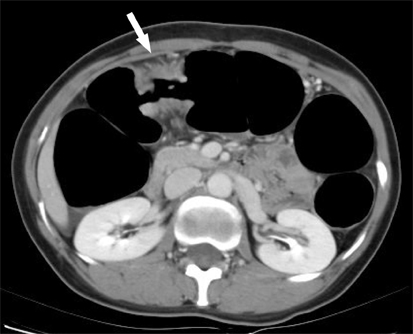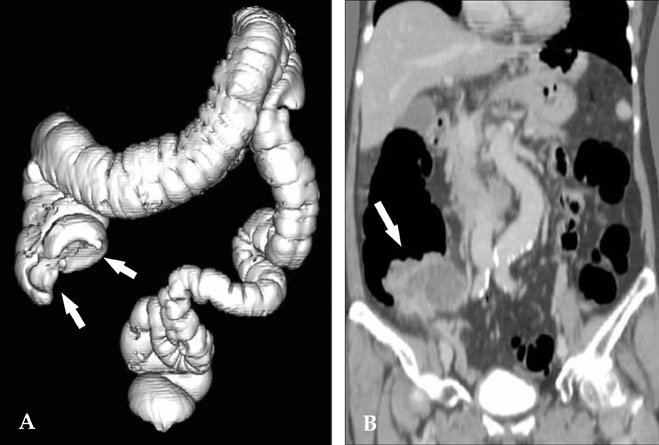Yonsei Med J.
2007 Dec;48(6):934-941. 10.3349/ymj.2007.48.6.934.
Incomplete Colonoscopy in Patients with Occlusive Colorectal Cancer: Usefulness of CT Colonography According to Tumor Location
- Affiliations
-
- 1Department of Diagnostic Radiology, Yonsei University College of Medicine, Seoul, Korea. pavane@yuhs.ac
- 2Division of Gastroenterology, Department of Internal Medicine, Yonsei University College of Medicine, Seoul, Korea.
- 3Department of Surgery, Yonsei University College of Medicine, Seoul, Korea.
- KMID: 1786206
- DOI: http://doi.org/10.3349/ymj.2007.48.6.934
Abstract
- PURPOSE: We sought to evaluate the clinical usefulness of CT colonography (CTC) after incomplete conventional colonoscopy (CC) for occlusive colorectal cancer (CRC) according to the tumor location. MATERIALS AND METHODS: Seventy-five patients with occlusive CRC underwent subsequent CTC immediately after incomplete CC. Fifty-nine patients had distal CRC and 16 had proximal colon cancer. Experienced radiologists prospectively analyzed the location, length, and TNM staging of the main tumor. The colorectal polyps in the remaining colorectum and additional extraluminal findings were also recorded. Sixty-seven patients underwent colorectal resection. We retrospectively analyzed the surgical outcome and correlated CTC and CC findings. RESULTS: The overall accuracies of tumor staging were: T staging, 86%; N staging (nodal positivity), 70% (80%); and intra-abdominal M staging, 94%. Additional colonic polyps were found in 23 patients. Six synchronous carcinomas were detected (9%); three in the proximal colon and three in the distal colon of occlusion. Clinically significant localization errors at CC were noted in 8 patients (12%, 5 proximal colon cancers and 3 distal CRCs) and were corrected by CTC. After CTC, the surgeons modified the initial surgical plan in 11 cases (16%). CONCLUSION: In occlusive CRC, CTC is not only useful in the evaluation of the proximal bowel, but can also provide surgeons with accurate information about staging and tumor localization. CTC is recommended when endoscopists encounter occlusive CRC, regardless of tumor location.
MeSH Terms
Figure
Reference
-
1. Nelson DB, McQuaid KR, Bond JH, Lieberman DA, Weiss DG, Johnston TK. Procedural success and complications of large-scale screening colonoscopy. Gastrointest Endosc. 2002. 55:307–314.
Article2. Cirocco WC, Rusin LC. Factors that predict incomplete colonoscopy. Dis Colon Rectum. 1995. 38:964–968.
Article3. Rex DK, Mark D, Clarke B, Lappas JC, Lehman GA. Colonoscopy evaluations: justification by cost? Am J Gastroenterol. 1996. 91:614–615.4. Marshall JB, Barthel JS. The frequency of total colonoscopy and terminal ileal intubation in the 1990s. Gastrointest Endosc. 1993. 39:518–520.
Article5. Chong A, Shah JN, Levine MS, Rubesin SE, Laufer I, Ginsberg GG, et al. Diagnostic yield of barium enema examination after incomplete colonoscopy. Radiology. 2002. 223:620–624.
Article6. Brown AL, Skehan SJ, Greaney T, Rawlinson J, Somers S, Stevenson GW. Value of double-contrast barium enema performed immediately after incomplete colonoscopy. AJR Am J Roentgenol. 2001. 176:943–945.
Article7. Neri E, Giusti P, Battolla L, Vagli P, Boraschi P, Lencioni R, et al. Colorectal cancer: role of CT colonography in preoperative evaluation after incomplete colonoscopy. Radiology. 2002. 223:615–619.
Article8. Morrin MM, Farrell RJ, Raptopoulos V, McGee JB, Bleday R, Kruskal JB. Role of virtual computed tomographic colonography in patients with colorectal cancers and obstructing colorectal lesions. Dis Colon Rectum. 2000. 43:303–311.
Article9. Fenlon HM, McAneny DB, Nunes DP, Clarke PD, Ferrucci JT. Occlusive colon carcinoma: virtual colonoscopy in the preoperative evaluation of the proximal colon. Radiology. 1999. 210:423–428.
Article10. Mauchley DC, Lynge DC, Langdale LA, Stelzner MG, Mock CN, Billingsley KG. Clinical utility and cost-effectiveness of routine preoperative computed tomography scanning in patients with colon cancer. Am J Surg. 2005. 189:512–517.
Article11. McAndrew MR, Saba AK. Efficacy of routine preoperative computed tomography scans in colon cancer. Am Surg. 1999. 65:205–208.12. Scharling ES, Wolfman NT, Bechtold RE. Computed tomography evaluation of colorectal carcinoma. Semin Roentgenol. 1996. 31:142–153.
Article13. Balthazar EJ, Megibow AJ, Hulnick D, Naidich DP. Carcinoma of the colon: detection and preoperative staging by CT. AJR Am J Roentgenol. 1988. 150:301–306.
Article14. Thoeni RF. Colorectal cancer: cross-sectional imaging for staging of primary tumor and detection of local recurrence. AJR Am J Roentgenol. 1991. 156:909–915.
Article15. Gazelle GS, Gaa J, Saini S, Shellito P. Staging of colon carcinoma using water enema CT. J Comput Assist Tomogr. 1995. 19:87–91.
Article16. Zerhouni EA, Rutter C, Hamilton SR, Balfe DM, Megibow AJ, Francis IR, et al. CT and MR imaging in the staging of colorectal carcinoma: report of the Radiology Diagnostic Oncology Group II. Radiology. 1996. 200:443–451.
Article17. Filippone A, Ambrosini R, Fuschi M, Marinelli T, Genovesi D, Bonomo L. Preoperative T and N staging of colorectal cancer: accuracy of contrast-enhanced multi-detector row CT colonography-initial experience. Radiology. 2004. 231:83–90.
Article18. Chung DJ, Huh KC, Choi WJ, Kim JK. CT colonography using 16-MDCT in the evaluation of colorectal cancer. AJR Am J Roentgenol. 2005. 184:98–103.
Article19. Jin KN, Lee JM, Kim SH, Shin KS, Lee JY, Han JK, et al. The diagnostic value of multiplanar reconstruction on MDCT colonography for the preoperative staging of colorectal cancer. Eur Radiol. 2006. 16:2284–2291.
Article20. Arenas RB, Fichera A, Mhoon D, Michelassi F. Incidence and therapeutic implications of synchronous colonic pathology in colorectal adenocarcinoma. Surgery. 1997. 122:706–710.
Article21. Langevin JM, Nivatvongs S. The true incidence of synchronous cancer of the large bowel. A prospective study. Am J Surg. 1984. 147:330–333.22. Chu DZ, Giacco G, Martin RG, Guinee VF. The significance of synchronous carcinoma and polyps in the colon and rectum. Cancer. 1986. 57:445–450.
Article23. Isler JT, Brown PC, Lewis FG, Billingham RP. The role of preoperative colonoscopy in colorectal cancer. Dis Colon Rectum. 1987. 30:435–439.
Article24. Evers BM, Mullins RJ, Matthews TH, Broghamer WL, Polk HC Jr. Multiple adenocarcinomas of the colon and rectum. An analysis of incidences and current trends. Dis Colon Rectum. 1988. 31:518–522.25. Barillari P, Ramacciato G, De Angelis R, Gozzo P, Indinnimeo M, Valabrega S, et al. Effect of preoperative colonoscopy on the incidence of synchronous and metachronous neoplasms. Acta Chir Scand. 1990. 156:163–166.26. Pagana TJ, Ledesma EJ, Mittelman A, Nava HR. The use of colonoscopy in the study of synchronous colorectal neoplasms. Cancer. 1984. 53:356–359.
Article27. Chen HS, Sheen-Chen SM. Synchronous and "early" metachronous colorectal adenocarcinoma: analysis of prognosis and current trends. Dis Colon Rectum. 2000. 43:1093–1099.28. Takeuchi H, Toda T, Nagasaki S, Kawano T, Minamisono Y, Maehara Y, et al. Synchronous multiple colorectal adenocarcinomas. J Surg Oncol. 1997. 64:304–307.
Article29. Bat L, Neumann G, Shemesh E. The association of synchronous neoplasms with occluding colorectal cancer. Dis Colon Rectum. 1985. 28:149–151.
Article30. Ajaj W, Lauenstein TC, Pelster G, Holtmann G, Ruehm SG, Debatin JF, et al. MR colonography in patients with incomplete conventional colonoscopy. Radiology. 2005. 234:452–459.
Article31. Hartmann D, Bassler B, Schilling D, Pfeiffer B, Jakobs R, Eickhoff A, et al. Incomplete conventional colonoscopy: magnetic resonance colonography in the evaluation of the proximal colon. Endoscopy. 2005. 37:816–820.
Article32. Wong TY, Lam WW, So NM, Lee JF, Leung KL. Air-inflated magnetic resonance colonography in patients with incomplete conventional colonoscopy: Comparison with intraoperative findings, pathology specimens, and follow-up conventional colonoscopy. Am J Gastroenterol. 2007. 102:56–63.
Article33. Vignati P, Welch JP, Cohen JL. Endoscopic localization of colon cancers. Surg Endosc. 1994. 8:1085–1087.
Article34. Hancock JH, Talbot RW. Accuracy of colonoscopy in localisation of colorectal cancer. Int J Colorectal Dis. 1995. 10:140–141.
Article35. Lam DT, Kwong KH, Lam CW, Leong HT, Kwok SP. How useful is colonoscopy in locating colorectal lesions? Surg Endos. 1998. 12:839–841.
Article36. Piscatelli N, Hyman N, Osler T. Localizing colorectal cancer by colonoscopy. Arch Surg. 2005. 140:932–935.
Article37. Corman ML. Carcinoma of the Rectum. Colon & Rectal Surgery. 2005. 5th ed. New York: Lippincott Williams & Wilkins;911–921.
- Full Text Links
- Actions
-
Cited
- CITED
-
- Close
- Share
- Similar articles
-
- Virtual CT Colonoscopy and Virtual CT Barium Enema using Multidetector-row CT
- A Comparison of Patient Acceptance and Preferences Between CT Colonography and Conventional Colonoscopy in Colorectal Cancer Screening
- Utility of CT colonography in detecting colon polyps as a colon cancer screen
- Diagnostic Performance of CT Colonography for the Detection of Colorectal Polyps
- Efficacy of CT Colonography in the Detection of Colorectal Polypoid Lesions




